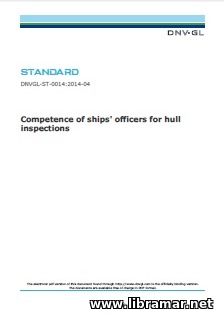 The present standard prepared and officially published by DNV GL class society, one of the leaders in the field of marine and offshore classification, covers the tasks of inspecting the hull of the vessel, both internally and externally. It requires the inspection of the external hull and ship's deck.
In all cases the associated survey must be performed whilst the vessel is in-service and in dock. This official DNV GL standard is therefore intended to provide a core set of competences for inspection. It excludes any effects of specific coatings from named manufacturers or specifics for specialized vessels. It will assist the owners of the vessels in their responsibility towards the integrity of their vessels by means of obtaining timely and structured info on the hull condition.
However, it shall be noted that the present document doesn't cover all competencies that might be required to be qualified for the survey of vessels. The authors team of the standard focused on the competences required to inspect and report the condition of the hull. Any safety requirements that are required to properly conduct the inspections therefore lie outside the scope of the standard. Below you may find the relevant quotes from the ISM Code and STCW 78, as amended...
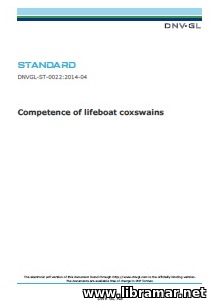 Effective operating of the lifeboats on board ships poses specific challenges for the lifeboat coxswain and crew members with reference to their launching and recovery as well as handling the boat and survival in any hostile environment, following the abandonment.
The present overview of competencies provided by the professionals of the DNV GL class society will help the shipping and offshore industry, from a safety management and a training and assessment perspectives. The emphasis of this standard has been made on the emergency evacuation activities, using the motor-propelled survival crafts. Both conventional and free-fall types of lifeboats have been covered by the competencies in this standard. Such competencies shall also apply to operating a designated lifeboat for the purposes of rescue or towing.
Taking into account that the davit-launched liferafts are often considered a back-up means in cases where a lifeboat becomes unavailable, the coxswain must also have good skills in preparing and launching this type of rescue craft, with the crew member assigned to him. In case these rafts are treated as a primary means of evacuation, the emergency organisation on board must have dedicated crew members for both the launching stations and the liferafts, whose tasks will differ from the lifeboat coxswain that are addressed in this standard. The basic sea-survival competencies required for all seafarers are not covered by this document.
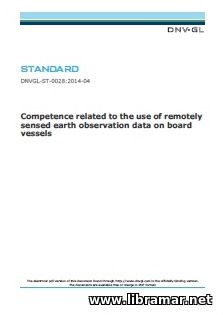 The present DNV GL standard was developed with the intention to establish a proper foundation and common ground for both the development of competence of individuals and for training programs relating to the use of earth observation data and products.
It could be used by organizations to define their expectations towards training providers, by training developers and providers as the backbone of a learning program, by companies to verify the competence of their people and define their training needs, and by verifiers as a reference document for independent evaluation of training programs. Of course, the specific details relating to the ship-specific arrangements and systems can't be captures in a general standard. The constantly increasing ice of earth observation data on board ships is providing so many new opportunities and can definitely supply sailors with so much of valuable information.
Today, the current use of such data in ice information and meteorology forms one of the parts of number of useful services, which is also increasing. Officers on board merchant and navy ships are becoming more and more familiar with earth observation data and, of course, it is very important that their competency allows them to properly analyze the quality of the provided data.
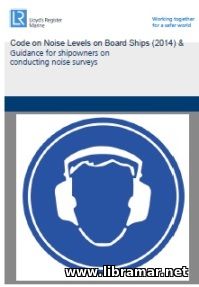 Here is the publication which was prepared by LR professional and officially by Lloyd's Register marine department; the team of authors combined the Code on Noise Levels on Board Ships in order to provide the owners of the vessels with the required technical guidance to follow during the noise surveys.
The Code itself, apart from the general information, contains the requirements to the measuring equipment and process of measurement, applicable noise exposure limits, insulation issues, hearing protection and warning information, reporting format, inclusion of noise issues in SMS, methods of attenuating noise, and simplified procedure for determining the exposure to noise.
The Guidance, in turn, provides readers with a quick review of the new for new noise legislation, assessment condition, noise assessment procedures, maximum levels of noise, insulation and reporting, all supplemented with a number of tables and figures. In fact, the number of publication addressing the noise level measurements, associated procedures and regulation, is not that huge so we would recommend this booklet to anyone involved in this process as well as to the owners, crew members, class and PSC inspectors.
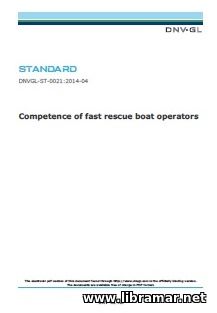 DNV-GL Standard DNVGL-ST-0021:2014-04. Introduction - Scope, Target groups, Professional profile, Required performance standard; Taxonomy - General, Level of cognition, Professional behaviour verbs; Competence requirements - General; References.
Operating the FRC poses some special challenges for the operator and crew with reference to such aspects of operation as launching and recovery of the boat, performing of the search and rescue activities, handling the boat in a hostile environment, and first-aid techniques. People often underestimate the importance and complexity of the tasks mentioned above, as well as of the skills required to effectively perform those tasks.
The operator competencies defined within the present standard shall be considered essential for safe and successful performance of these tasks. The emphasis in the book is lies primarily on open water operations; however, the operations performed on shallow water have also been covered to some extent. The publications is aimed to people who are in charge of the fast rescue boats. The operators of such boats should always be able to coordinate and launch the boat, take command and operate the boat in different weather conditions without creating any dangerous situations...
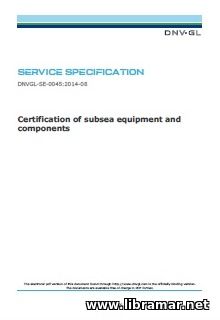 This service specification by DNV GL is intended to describe the certification service for the various subsea equipment and subsea components provided by this classification society. It identifies and describes all verification activities that are to take place in the course of the design and manufacturing of such subsea equipment/components. Subject activities are considered mandatory in order for the subsea equipment/components to be issued the DNV GL certificate.
The main objectives of this specification are to describe the DNV GL certification service, to specify the corresponding certification procedure in place, to the define the correct extent of verification activities required by this class society, and to provide a common platform for the contracting parties to communicate. The certification process has been described in detail, including the design and material verification, and manufacturing assessment.
The section describing the certification requirements tells the readers about proper categorization of the subsea equipment, and provides all applicable documentation requirements. The appendix at the end of the document provides standardized documentation types.
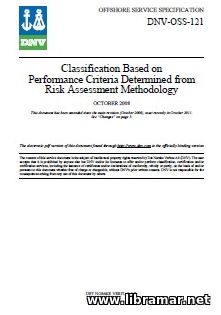 The present document presents the service specification released by DNV Class Society for classification of offshore installations on the basis of the various risk assessment techniques. This would mean that the acceptability of design as well as of the extent of verification are basing on rthe isk assessment rather than reliance upon the prescriptive rules.
The primary objective of such approach is to provide an alternative route for classification of individual and/or novel designs whilst trying to maintain an acceptable level of safety and integrity that could ve considered equivalent to that achieved under more traditional class societies' rules. Though not mentioned specifically through the present document, avoidance of adverse environmental consequences must be taken into account as necessary, to the extent covered by traditional class rules. The requirements provided in this publication shall apply to the fixed offshore installations, including floating ones designed for use at a fixed location.
The service is alternative or complementary to classification based on other DNV service specifications (DNV-OSS series) for such installations. Where classification based on risk assessment is applied only to a part of an installation, the remainder of the installation shall meet the requirements of other applicable DNV rules. In such cases, it is critically important to ensure a safe interface between the two classification methods i.e. that design based on risk assessment does not have a negative effect upon safety or integrity under classification rules and vice versa...
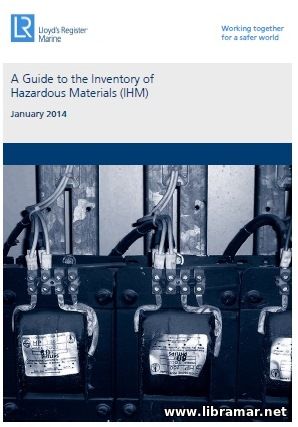 The present Guide was published by Lloyds Register this year. It includes valuable information on the EU Regulations on Ship Recycling and relevant Hong Kong Convention, as well as all requirements that apply to the initial approval for new construction and existing ships plus ones for maintaining the IHM, useful info on how to make the Inventory on board ships, in-service use, numerous common hazards and definitions.
Five appendices cover IMO list of hazards for all vessels, newbuildings and new installations, an example inventory of IHM, procedures for service suppliers approval, and suppliers and manufacturers information lists. The aim of the document is to provide necessary guidance on compiling the correct Inventory of Hazardous Materials (that was previously referred to as Green Passport) for submission to LR Class Society for review. The publication will be extended and updated in the future, as the technical knowledge of the subject develops; as a result, further info will be received from various regulatory bodies like IMO and included in this Guide.
In general, the Inventory shall comply with the Reg. 5 of the Hong Kong Convention and contain all potentially hazardous materials that are present in a vessel's structure, equipment and systems...
« 1 2 ... 23 24 25 26 27 ... 29 30 » |







